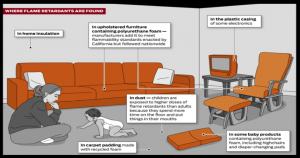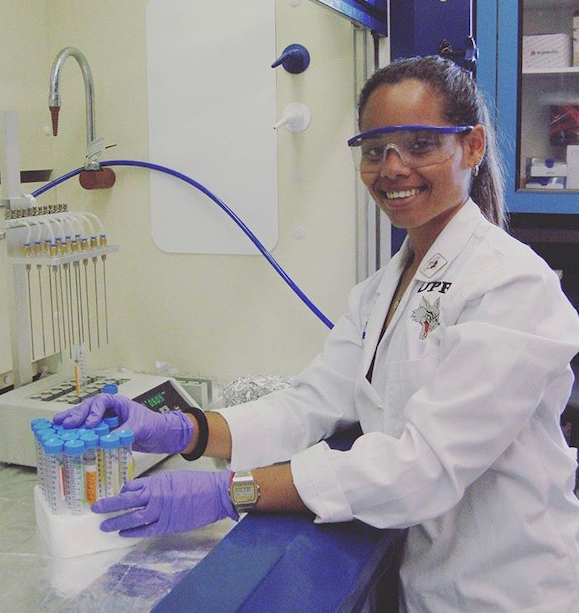Each summer, the University of Rhode Island Graduate School of Oceanography (GSO) hosts undergraduate students from all over the country to participate in oceanographic research. These Summer Undergraduate Research Fellows (SURFOs) have not only been working with GSO scientists, but they have spent part of their time learning how to communicate this science to the public. Read on to find out what they have been up to, and why they everyone should be as excited as they are about their work.
Jamillez Olmo Classen is a senior at the University of Puerto Rico at Arecibo, majoring in Technology in Industrial Chemical Process. This summer, she worked with Dr. Rainer Lohmann (advisor) and Dr. Jitka Becanova (mentor) studying harmful chemicals and how to properly measure their concentrations in our water supply. Read on below to learn about her work!
Background
Flame retardants, known as variety of substances or chemicals added to combustible materials to prevent fires, delay a fire’s start and provide additional time to escape from it. Being called flame retardants does not mean they’re a family of chemicals; they a variety of chemicals with different molecular structures and properties that act like flame retardants and are combined to be effective.

Today, flame retardants are used in four big industries: electronic and electrical devices (television, computers, etc.), furniture (different types of fabrics), building and construction materials (paint, home insulation, etc.), and transportation (eg. upholstery of cars, trains and even airplanes. In addition, they are used on clothes, mostly in military and firemen vests. As mentioned earlier, flame retardants can be found in many objects which we are exposed to daily and these chemicals can pose a huge threat to human health.
Fate of these chemicals
The use of flame retardants for our safety is a marvelous thing but it is not so great as we think. Some of the groups used or that behave as flame retardants are bad for both human and animal health. These groups are bromated and the replacement for these are the organophosphosphuros flame rettardants(OPFRs). Over the past 15 years, OPFRs were developed and used as flame retardants because of environmental and health concerns of previously used brominated and chlorinated flame retardants (FRs). Since these are chemicals added, meaning they are not naturally part of the object, the molecules of these chemicals can easily detach from the object added and fall to the surroundings. When detached, they spread out into air and water sources, and remain persistent in the environment for years, making it easy for us to be exposed to them. These chemicals can get into the air, water and dust during manufacture, exposing us to these harmful chemicals via inhalation or skin contact.

One of the most concerning avenues for chemical exposure is through our drinking supply. Unfortunately for us, most concentrations of OPFRs are found in different water sources that end up in our potable water supply exposing us in a dangerous way to different health complications. It is known that these compounds are neurotoxins and carcinogens and thus it is important to study their concentrations in different water sources to maintain a safe environment for everyone.
My summer work
This past summer I had the privilege to work in Rainer Lhomman’s lab at the Graduate School of Oceanography. I tested a passive sampler for emerging contaminants of concern in Narragansett Bay (NBay), especially the organophosphate esters (flame retardants). The project was based on testing a commonly used passive sampler called the polyethylene sheet (PEs) that is made up od plastic films cut into small sheets. The passive sampler was tested in a lab experiment for its performance with the compounds. In addition the polyethylene sampler was deployed in five different locations of NBay to observe the performance with OPEs in the field because of the sampler’s previsouly good performance with other compounds. Unfortunately the performance was not as good as expected because the concentrations absorbed by the PEs did not completely represent the concentrations in the water of the different locations. There needs to be more analyses and experiments to find a suitable passive sampler to measure the concentrations of these compounds in marine waters in order to help have a better environment for all.
Additional reference:
Ma-Yuxin, Xie-Zhiyong, Lohmann-Rainer, Mi-Wenying, Gao-Guoping (2017). Organophosphate Ester Flame Retardants and Plasticizers in Ocean Sediments from the North Pacific to the Arctic Ocean Environ. Sci. Technol.20175173809-3815 February 28, 2017
I love writing of all kinds. As a PhD student at the Graduate School of Oceanography (URI), I use using genetic techniques to study phytoplankton diversity. I am interested in understanding how environmental stressors associated with climate change affect phytoplankton community dynamics and thus, overall ecosystem function. Prior to graduate school, I spent two years as a plankton analyst in the Marine Invasions Lab at the Smithsonian Environmental Research Center (SERC) studying phytoplankton in ballast water of cargo ships and gaining experience with phytoplankton taxonomy and culturing techniques. In my free time I enjoy making my own pottery and hiking in the White Mountains (NH).



